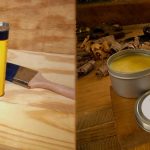How to Clean Polyurethane Brush?
Polyurethane is a go-to material for every wood turner. They’ve occupied a vast range of industries and had the most comprehensive application on furniture in the form of paint or coatings. But polyurethane brushes are costly. So, reusing them is wise instead of throwing them away after each application.
But how to clean polyurethane brushes to reuse? Okay, it will differ between oil-based and water-based polyurethane. After using oil-based poly, use paint thinner or mineral spirits to clean the brush. In contrast, you can clean it with just water with or without dish soap if you use water-based poly.
Come with us, and we’ll show you how to rinse off your polyurethane brush and use it multiple times.
How to Clean Polyurethane Brush?
There are two main types of polyurethane used for finishing: oil-based and water-based formulations. Each type has unique properties and requires specific cleaning methods for maintaining quality brushes.

How to Clean Oil-Based Polyurethane Brush?
Cleaning an oil-based polyurethane brush requires specific steps and materials to remove the resins and oils from the brush bristles effectively. Here are two methods you can follow to clean your oil-based polyurethane brushes:
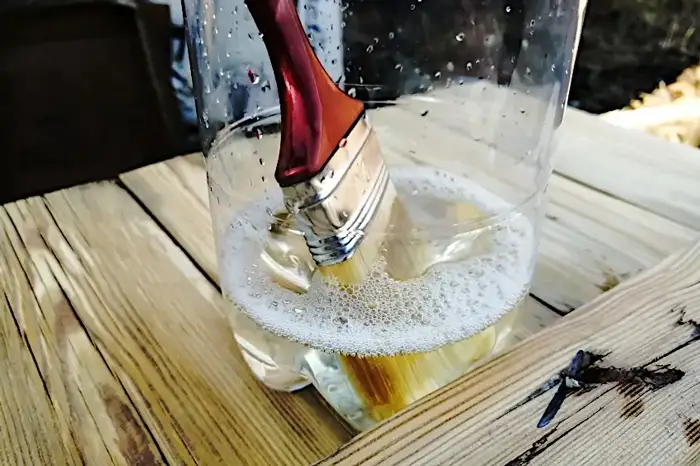
Things you need to clean the brush
- Mineral spirits
- A container
- Gloves
Method 1: Using Mineral Spirits
Here is a step-by-step Guide on how to clean oil-based polyurethane brushes using mineral spirits.
- Step 1. Put on gloves for protection.
- Step 2. Pour one cup of mineral spirits into the container.
- Step 3. Dip the brush into the mineral spirits, ensuring the bristles are fully submerged.
- Step 4. Allow the brush to soak in the mineral spirits for a few minutes. You may have to wait an hour if the polyurethane is already dried.
- Step 5. Repeat the soaking process if needed until the brush is clean.
- Step 6. When you notice dirty mineral spirits, it’s time to put off the brush.
- Step 7. Now, rinse with cold water.
- Step 8. Gently shake off excess liquid from the brush. Otherwise, it may spoil the brush.
- Step 9. Allow the brush to dry flat or hang it to air-dry.
Here is a video to better understand how to clean polyurethane brushes using mineral spirits.
Method 2: Using Paint Thinner
Another option to remove polyurethane from brushes is to use paint thinner. Here is a Step-by-Step Guide:
- Step 1. Put on gloves for protection.
- Step 2. Prepare a container (cup/bowl) with paint thinner.
- Step 3. Submerge the brush bristles into the paint thinner.
- Step 4. Swirl it in the solution.
- Step 5. Let the brush soak in the paint thinner for several minutes.
- Step 6. Remove the brush from the paint thinner and put the brush under running tap water.
- Step 7. Notice whether dirt slides off the brush bristles or not. Ideally, it should, but if it isn’t, you can use warm water.
- Step 8. Gently shake off excess liquid from the brush.
- Step 9. Dispose of the used paint thinner safely according to local regulations.
- Step 10. Use a paper towel to dry the brush before using it again.
How to Clean Water-Based Polyurethane Brush
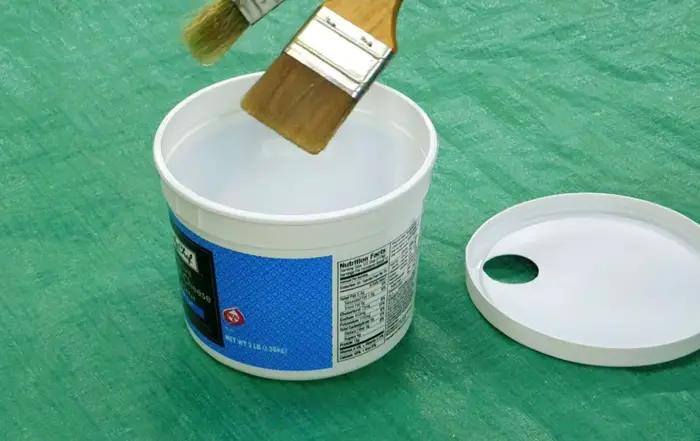
The cleaning process for water-based polyurethane differs from oil-based polyurethane brushes.
Things You Need
To effectively clean your water-based polyurethane brush, gather the following items:
- Warm Water
- Mild Soap
- A container
Method 1: Using Hot Water
This is to clean your brush without using any toxic chemicals. Only natural water can remove water-based polyurethane.
- First, collect hot water in a bucket, a cup, a bowl, or a sink.
- Submerge brush bristles and swirl in hot water. It will lose hardened paint.
- Allow the brush to soak for a few minutes, loosening the water-based residues.
- Try to scrub the brush in the water, facilitating residue removal.
- Remove the brush from the hot water.
- Shake off excess water from the brush.
- Repeat the soaking and agitation process if needed. Note you’re not using only hot water. So it may take time to remove the paint.
- Allow the brush to dry flat or hang it to air-dry.
Method 2: Using Soap and Water
Say, hot water is failing to remove your water-based polyurethane. Now, what? Use dish soap to facilitate the cleaning process. Here are the steps.
- Step 1. Wet the brush by pouring it into a container filled with warm water.
- Step 2. Now, put a few drops of dish soap on the bristles.
- Step 3. Then, scrub until there is a soap lather.
- Step 4. Remove the brush from the soapy water.
- Step 5. Rinse the brush under running water until clean. Continue the same process until the soap is completely removed.
- Step 6. Finally, let it dry.
Maintain and Store Your Brush Safely
Proper maintenance and storage of your polyurethane brush are crucial for ensuring its longevity and optimal performance. Here are essential tips to help you maintain and store your brush safely:
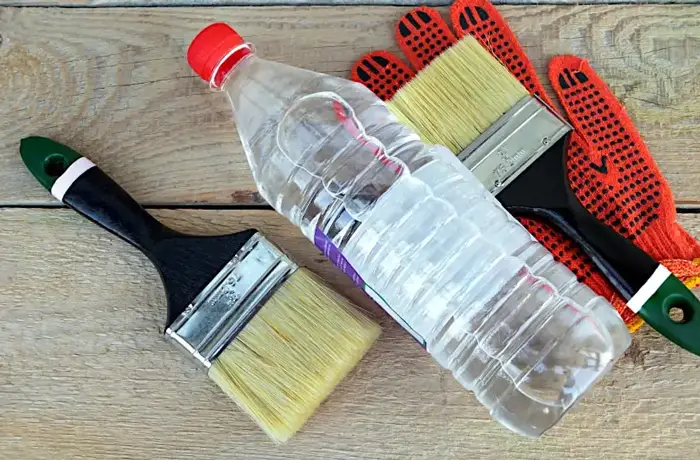
Cleaning After Use
Clean your brush immediately after use to prevent the polyurethane from hardening and damaging the bristles.
Combing the Bristles
After cleaning, use a brush comb or an old toothbrush to remove any remaining dried polyurethane from the bristles.
Avoiding Harsh Cleaning Agents
Use appropriate cleaning agents, such as mineral spirits for oil-based brushes and warm, soapy water for water-based brushes.
Proper Drying
Always allow the brush to dry completely before storing it to prevent mold or mildew growth.
Storing the Brush
Store your brush flat or hanging with the bristles down to maintain their shape.
Protective Covers
Use protective covers or wrap the brush in wax paper to shield it from dust and dirt while in storage.
Rotating Brushes
If you frequently use different types of polyurethane, consider having separate brushes for oil-based and water-based to avoid contamination.
Tips for Reviving Old Brushes
If you have an old, stiff brush, try soaking it in an appropriate cleaning agent for an extended period to help soften the bristles.
Safe Disposal of Solvents:
When disposing of solvents or paint thinner, follow local regulations to protect the environment.
Following these maintenance and storage tips ensures that your polyurethane brushes remain in excellent condition, providing consistent and reliable results.
Common Issues While Cleaning Polyurethane Brush
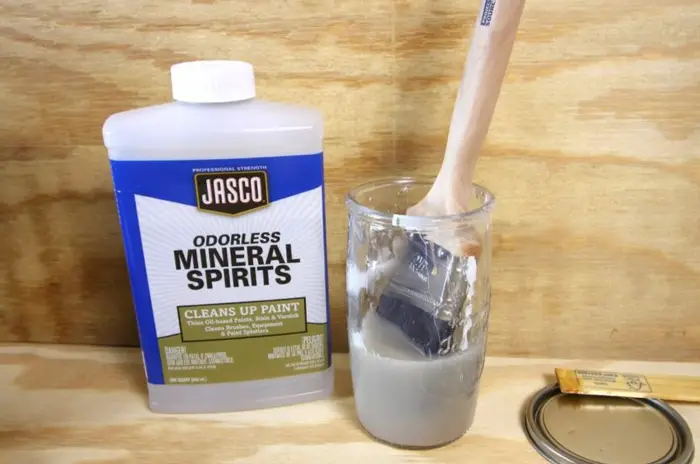
While cleaning your polyurethane brushes, you might encounter some common issues. Here are potential problems that could arise and how to address them:
- Stubborn Residues: If you notice stubborn residues that won’t come off during cleaning, use an old toothbrush to scrub the bristles gently.
- Hardened Bristles: If the brush bristles have become stiff and hardened, it might be a sign of improper cleaning or leaving the brush exposed to air for too long after use.
To restore the bristles’ flexibility, soak the brush for an extended period. Repeat the process until the bristles soften.
- Damaged Bristles: Inspect your brushes regularly for any signs of damage, such as fraying or split bristles. If you find any, it’s time to replace the brush.
- Paint or Polyurethane Dried Near Ferrule: Sometimes, paint or polyurethane can dry near the ferrule (the metal part that holds the bristles), causing the bristles to become stiff and lose their shape.
Prevent this issue by cleaning the brush thoroughly and removing all residues near the ferrule.
- Brush Misshaping: Improper storage, such as leaving the brush bristles facing upwards, can lead to misshaping over time. Always store the brushes with the bristles down or flat to maintain their shape.
- Strong Odors: Both oil-based and water-based polyurethane may have strong odors, especially during cleaning. Ensure proper ventilation when using solvents, and consider wearing a mask if you’re sensitive to fumes.
FAQs
Let’s address some common queries about cleaning polyurethane brushes:
Q: Is polyurethane brush reusable?
A: Yes, polyurethane brushes are reusable with proper care. Reusing a single brush multiple times is environmentally friendly, reducing waste and conserving resources. We minimize our ecological footprint by cleaning and maintaining brushes and contribute to a sustainable project approach.
Q: Can I use the same brush for oil-based and water-based polyurethane?
A: No. It’s best to use separate brushes for oil-based and water-based polyurethane to avoid cross-contamination and ensure consistent results.
Q: Is a thinning agent compulsory to clean a polyurethane brush?
A: No, it’s not mandatory, but using a thinning agent like mineral spirits can aid in removing stubborn residues from oil-based polyurethane brushes.
Q: How Mineral Spirit and Brush Cleaner Differ
A: Both are used for cleaning brushes. But brush cleaners may have additional cleaning agents, while mineral spirits are commonly used for oil-based polyurethane due to their solvent properties
Final Words
Finally, cleaning and maintaining polyurethane brushes are essential for longevity and optimal performance. Oil-based polyurethane brushes must be cleaned using particular solutions that break down the resins and oils in the material.
With a mild smell, quicker drying periods, and reduced VOC emissions, water-based polyurethane is a well-liked eco-friendly substitute for oil-based solutions. When cleaning brushes with water-based polyurethane, the water-based resins are mostly removed from the brush bristles using water and mild soap.




